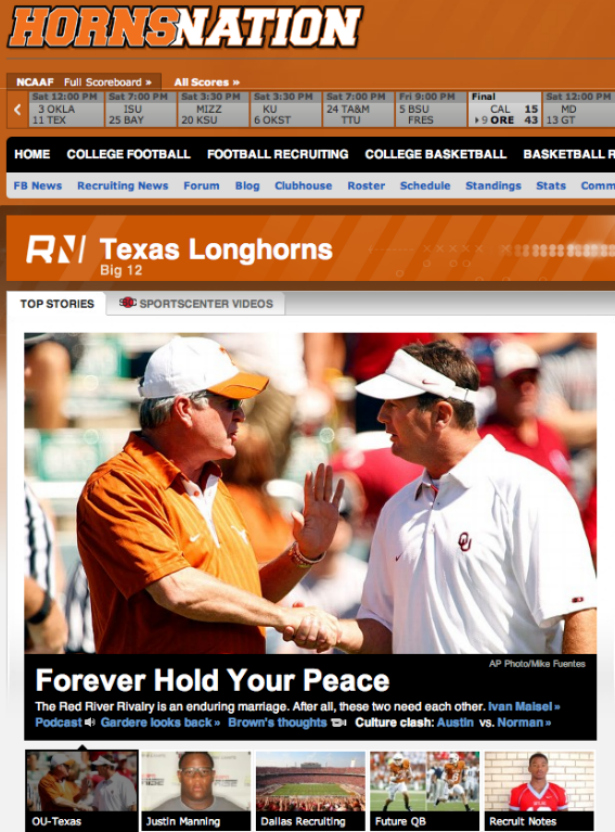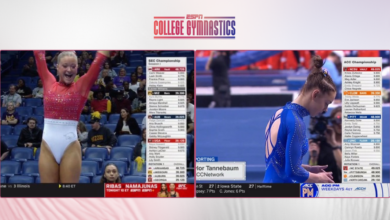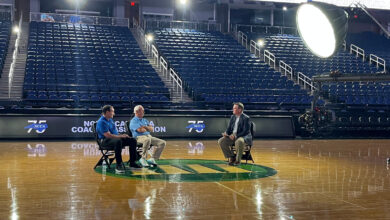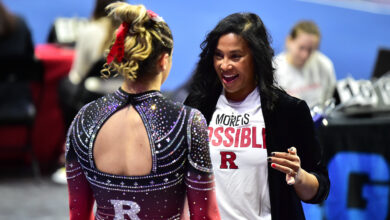Inside OU-Texas coverage
Third-ranked Oklahoma (4-0 overall, 1-0 Big 12) meets No. 11 Texas (4-0, 1-0) in another Red River Rivalry showdown in the Cotton Bowl (12 ET, ABC).
This game could have national championship implications, which is one reason ESPN’s College GameDay is all over this matchup.
This game also offers a great reason to showcase SoonerNation and HornsNation, ESPN’s two specialized websites devoted to coverage of the University of Oklahoma and the University of Texas, respectively.
They are just two of the “Nation” sites recently launched by ESPN. Others include DawgNation (Georgia), WolverineNation (Michigan) and We Are SC (USC).
Front Row asked Jeremy Crabtree, ESPN’s Senior Recruiting Coordinator who oversees the Nation projects, SoonerNation’s Jake Trotter and HornsNation’s Carter Strickland to reflect upon the websites.
FR: What is the focus of the entire “Nation” project, and what does the future hold?
Crabtree: Our goal is to use the resources of the World Wide Leader in sports to bring the best localized college sports content to fans. To do this, we focused on bringing in the best beat writers and recruiting writers in the nation’s top college markets. We already have sites for USC, Texas, Oklahoma, Michigan and Georgia and have plans to expand. We also have a great partnership with the ESPN.com college sports team and Insider and have built out our staff on the national and regional recruiting level. Those relationships, the school specific writers and additional hires on the recruiting staff have created a compelling package of content for fans.
FR: When someone asks you to describe what HornsNation/SoonerNation is, how do you describe it in laymen’s terms?
Trotter: I say it’s taking the best of what newspapers do, and the best of what the recruiting services do, and combining into one entity. Newspapers have the ability and track record of writing great features, trend pieces and enterprise stories. Recruiting services (Rivals, Scout) do a good job breaking recruiting commitments and staying on top of college football’s feeder system. But they rarely write stories of any substance. With these sites, we have the platform to do both at a high level.
Strickland: We are the spot for all the Texas football news, including recruiting and multimedia. We try to do it all and feel like we are successful on most days. What helps is that we have a strong database of information on the team and on recruits.
FR: The Red River Rivalry seems like it would be your sites’ Super Bowl. How do you cover your day-to-day sports, monitor recruiting, and still amass what you need to produce RRR advances?
Trotter: Everything we write — and we’ve produced a ton of content this week — is related to the game. The key is to connect everything to the game. So when it comes to covering recruiting, it’s important the angles pertain to OU-Texas. What do prospective recruits think about one day playing in this game? How does the game affect recruiting for the winner? How does the game in and of itself affect recruiting?
This game has so much tradition, you must also bring in a historical context. Notable head-to-head recruiting wins and losses, significant victories on the field and how everything from conference realignment to coaching salaries seems to come back to this game. Oh, and you write about the actual game itself, too.
Strickland: We get a ton of help from the editors, recruiting writers and the national guys like Ivan Maisel and Pat Forde pitch in. That is really the only way all the stuff that has to be done could get done. With all of those people helping out what we are trying to give the readers are some diverse and interesting angles.
FR: What aspects of your journalistic backgrounds lend themselves to covering these beats?
Trotter: I covered the OU football team for four years with The Oklahoman, and have been in sports journalism since my sophomore year of college. I also have experience managing a team from my time with Cox Newspapers, which is helpful considering this is a collaborative effort internally at SoonerNation, and with all of the college sites.
Strickland: I grew up in Texas, went to UT, covered OU and have covered several other college beats around the country in my almost 20 years of sports journalism. While UT presents its own challenges, most beats are pretty similar at their core — it is about getting the news and trying to tell the stories in a way that is unique and engaging for the readers. That means going one or two steps beyond at times, but almost always the extra phone call or source makes the story that much better.
FR: What’s surprised you about working these beats so far?
Trotter: To be honest, nothing has been too surprising thus far, considering the job is not too dissimilar from what I was doing before. I will say, though, working for “ESPN.com” carries a cache that makes it easier to get people on the phone or to get them to disclose information.
Strickland: The presentation and way stories are played is far superior to what other media platforms can and have offered in the past. Additionally what we are able to do is build an entire network of sites for those college football fans who want to know everything about the team on the field, the coaches behind that team and the next generation of players who are being recruited.
FR: Who wins Saturday and why?
Trotter: Oklahoma 21, Texas 16. The Longhorns are better this year, but so are the Sooners. The team with the more experienced quarterback usually prevails in this game, and in Landry Jones, OU has the more experienced quarterback.
Strickland: Oklahoma should win because Texas just has too much youth on crucial spots on both sides of the ball. The Longhorns are playing 18 true freshmen and have first-year starters in vital spots such as quarterback, running back, wide receiver, center and defensive back.
Snapshot of SoonerNation:
Snapshot of HornsNation:









